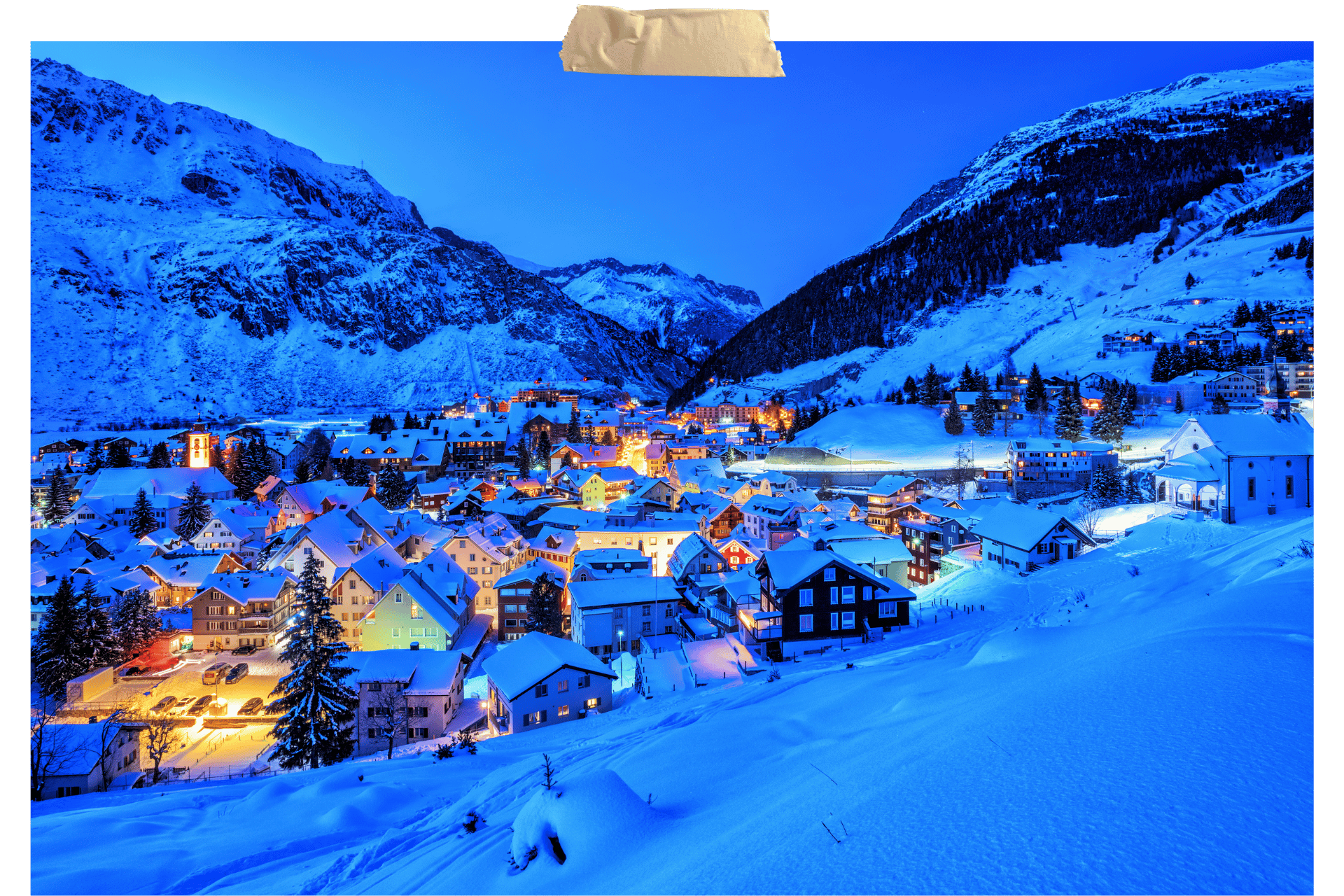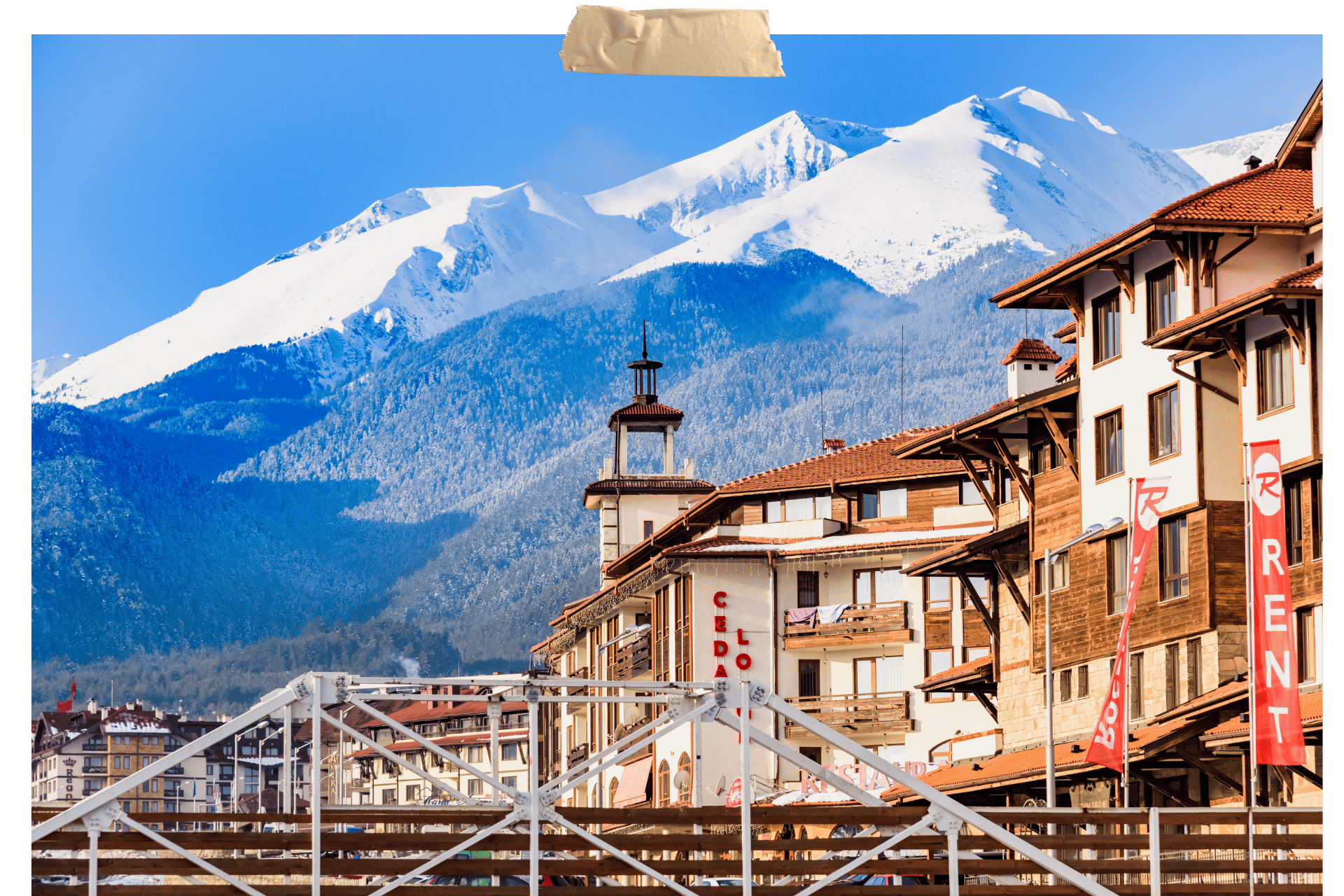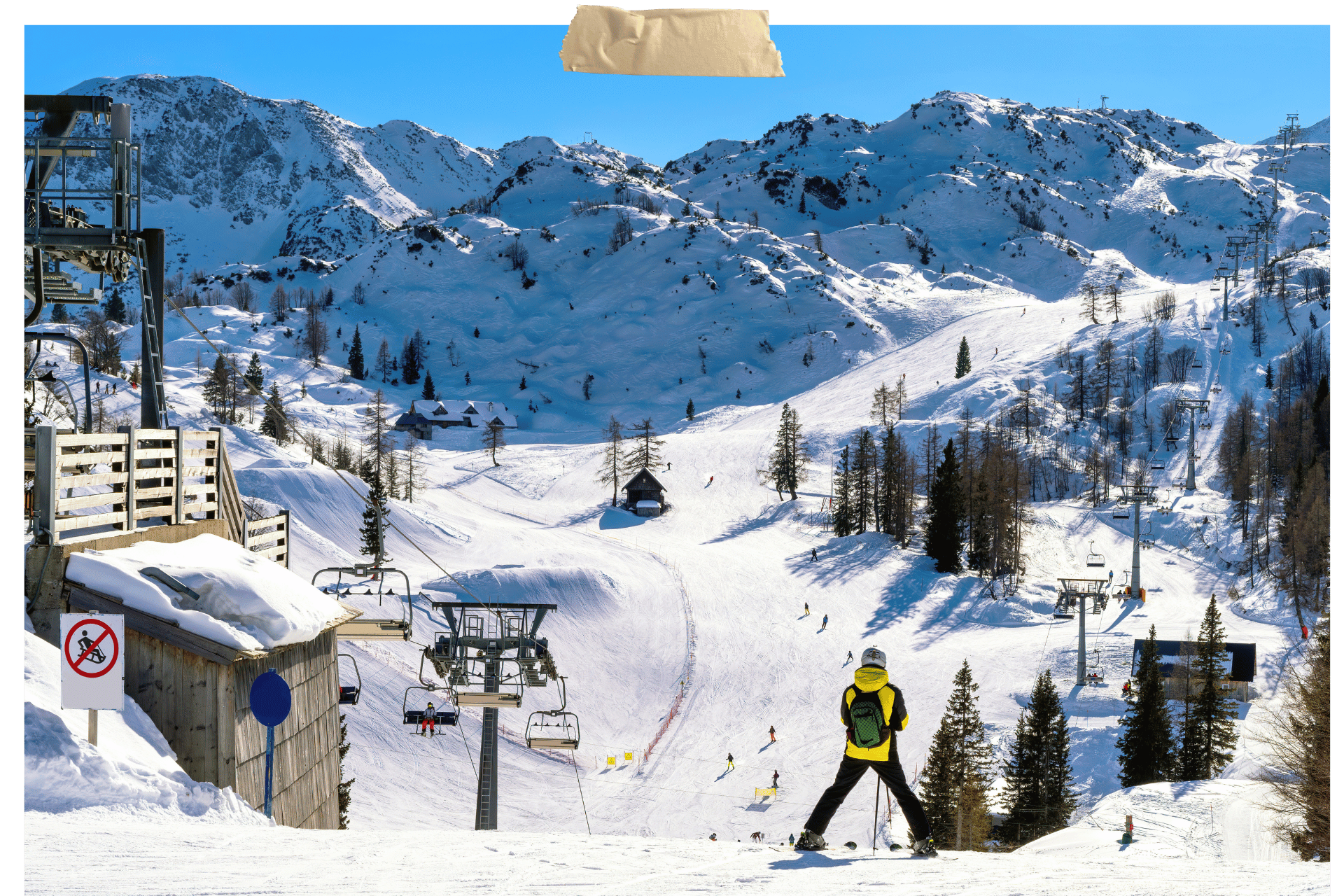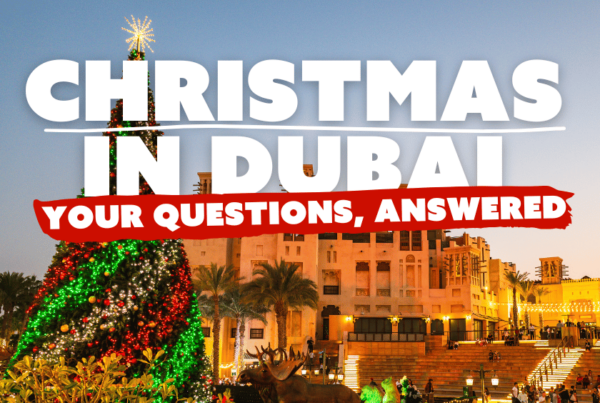Keen for a ski trip, but not so keen on the queues for the gondola? We’ve put our snow boots on and got stuck in with our list of Europe’s lesser-known ski resorts – move over Zermatt and St Moritz!
There’s a good mix of resorts in here, from nice and easy ones if it’s baby’s first ski trip, to ones with more black runs (that’s ski lingo for tricky). And the best bit? They won’t cost you a bomb, whilst still keeping all the charm of a proper ski resort – we’re talking chalets, delish local food, and cosy après-ski set-ups aplenty.
Psst: Canada’s a classic for ski trips, and you can have a look at our round up of the best ones here.
Andermatt, Switzerland
Zermatt, without the cha-ching

Season: November to May
While Switzerland is known for glam ski resorts (hello Zermatt), Andermatt remains a bit of a hidden treasure. You’ll find it in the heart of Switzerland in the Ursern Valley, at the crossroads of several Alpine passes (Furka, Oberalp, and Gotthard). Well-connected by rail and road, it’s relatively easy to reach and yet it keeps that remote, less commercialized vibe.
On the slopes
With a blend of more challenging terrain and uncrowded slopes, the ski area is divided into several areas. Gemsstock (Andermatt’s main peak) is famous for its challenging terrain, steep slopes, and off-piste skiing. It’s particularly suited for advanced skiers and freeriders – Andermatt has earned a bit of a reputation as one of the best freeride spots in Europe, with reliable snow, long runs, and tricky descents. Nätschen-Sedrun, meanwhile, is perfect for beginners and intermediates, with wide, open pistes that offer beautiful views and less crowded slopes.
Off the slopes
Besides all that skiing malarky, Andermatt has a long history as a traditional Swiss village, and unlike some more commercialized resorts, it’s kept a tight hold of its proper charm. Think traditional Swiss architecture with picturesque wooden chalets, narrow streets, and a seriously serene atmosphere.
It’s also got a more relaxed and intimate après-ski scene, which is ideal for those who prefer cozy evenings over lively parties. There’s a few good bars too – try the The River House or Spycher, both offering local beers, Swiss wines, and live music in the evenings.
For non-skiers, there’s a bunch of stuff you can do, from sledding runs down Nätschen and snowshoeing trails that explore the stunning Alpine landscapes around you to winter hiking trails with incredible views of the surrounding peaks.
Oh, and the Glacier Express, one of the world’s most famous scenic train rides, just so happens to pass through Andermatt too.
Getting there
By train
Andermatt is very accessible by Switzerland’s efficient rail system. It’s about 2 hours from Zurich by train, making it easy to reach for international visitors.
By car
The village is about a 90-minute drive from Zurich, and while the roads are well-maintained, it’s advisable to check the weather conditions, especially during winter.
Livigno, Italy
It’s all about the Alps, not about the crowds
Season: November to early May
Livigno is mega charming and one of Europe’s lesser-known ski resorts tucked away in the Lombardy region of Italy, right on the border between St. Moritz (on the Swiss side) and Bormio (on the Italian one). It’s excellent for skiers (there’s over 115 km of well-groomed pistes) seeking expansive terrain, reliable snowfall, and a vibrant yet laid-back après-ski scene, all while enjoying the rather lovely added bonus of tax-free shopping. It’s that perfect blend of affordability and quality, making it a fab alternative to the busier and pricier resorts in the Alps (of which there are many).
On the slopes
Livigno is one of the highest resorts in Europe, which translates to a long ski season, as well as offering over 115 km of skiable terrain spread across two main areas: Mottolino and Carosello 3000.
It’s pretty ideal for the beginners and intermediates amongst you, with around 40% of the runs designated as blue (that’s ski lingo for easy) and 45% as red (that’s intermediate). The wide, open slopes of Carosello 3000 are perfect for leisurely skiing and carving, while the Mottolino side provides slightly more challenging red runs for those looking to progress.
Though the resort is beginner-friendly, there’s still 15% black runs (ooooh, these are for the hardcore skiers only), particularly on the Mottolino side, where more challenging, steep slopes can be found. Livigno is also a top destination for freestyle skiers and snowboarders, with the Mottolino Snowpark one of the best in Europe, featuring various jumps, rails, and a half-pipe.
For those interested in Nordic skiing, Livigno boasts around 30 km of cross-country trails winding through the picturesque valley, and it’s also one of the few resorts in Europe to offer fat biking on snow. This is where, with specially designed wide-tired bikes, you can explore the snowy landscape along designated winter biking trails.
Good to note: Livigno’s size means skiers need to use local buses or make the 10-minute connection between the Mottolino and Carosello areas. But the good thing is the free shuttle service is convenient and frequent, making it easy to navigate between the two.
Off the slopes
There’s a vibrant, yet relaxed après-ski culture here. And while it’s not as wild as resorts like St. Anton or Verbier, there’s still plenty of bars, pubs, and restaurants – try the Stalet Bar near the Mottolino base, one of the most popular après-ski spots and known for its lively atmosphere, live DJs, and outdoor parties. Kosmo Bar, located near the Carosello 3000, is another hotspot for drinks, snacks, and music.
One of Livigno’s unique selling points is its duty-free status, which means you can shop for alcohol, tobacco, electronics, clothing, and perfumes – a load of stuff, really – at significantly reduced prices compared to the rest of Italy, and the resort runs the gamut from designer outlets to souvenir stores.
Besides shopping, Livigno is also known for its excellent nosh, ranging from cozy pizzerias to upscale Italian restaurants serving local Valtellina cuisine. Don’t miss traditional dishes like pizzoccheri (buckwheat pasta with potatoes, cheese, and greens), sciatt (fried cheese balls), and bresaola (air-dried beef).
Getting there
By train
Depending on where you to choose to fly into, you can take a train to Zernez (Switzerland) or Tirano (Italy), and from there, continue by bus to Livigno.
By car
The nearest airports are in Milan (3.5 hours by car) and Innsbruck (2.5 hours). The drive is spectacular but passes through high mountain roads and tunnels. The most famous access is via the Munt La Schera Tunnel, connecting Livigno to Switzerland.
Bansko, Bulgaria
Mega value for money and mixed abilities

Season: Mid-December to mid-April
Bansko, Bulgaria is one of Eastern Europe’s lesser-known ski resorts that’s rapidly on the rise, offering excellent value for money. It’s particularly appealing for skiers looking for affordable lift tickets, accommodation, and dining without sacrificing the quality of the skiing experience. Located in the Pirin Mountains, Bansko’s got well-maintained slopes, a lively après-ski scene, and a charming historical town to boot. We’re in.
Around 160 km (100 miles) from Sofia, the capital of Bulgaria, and around 150 km (93 miles) from Plovdiv, it’s easily accessible from major cities.
On the slopes
Bansko has over 75 km of marked runs, primarily spread across the slopes of Todorka Peak, and is an excellent resort for beginners, with about 30% of the slopes classified as easy (green and blue). The Bunderitsa and Shiligarnika areas offer gentle, wide pistes – ideal for learning and practicing if you’re a bit rusty.
Around 45% of Bansko’s slopes are classified as red, providing plenty of serious terrain for confident skiers. The runs on the upper slopes, particularly around Tomba (the resort’s famous red run, named after Italian skier Alberto Tomba), are long, well-groomed, and offer fantastic views of the surrounding mountains.
There’s around 25% black runs here too, like the Tomba black run, a former World Cup slope and a fave among expert skiers for its challenging steep sections. There’s also some great off-piste options for experienced skiers, though guided tours are recommended due to avalanche risks.
A robust network of snowmaking machines cover about 90% of the slopes here. The best natural snow conditions are typically found between January and March, but even during low-snow periods, the resort manages to maintain good coverage.
Off the slopes
Bansko has a pretty lively après-ski scene, especially compared to other Eastern European resorts, and the town itself is a unique mix of modern infrastructure and old-world charm, with cobbled streets and traditional homes.
Unlike the high-end après-ski in Western Europe, Bansko’s bars offer more affordable drinks (get in), which contributes to its appeal for younger travellers and more budget-conscious skiers. Try Happy End, one of the most popular bars in Bansko and located at the base of the gondola, offering live music and DJs, or Jack’s House, known for being a more laid-back spot, with great cocktails and a cosy atmosphere.
Another highlight of a trip to Bansko is the mega food, particularly at the traditional Bulgarian mehanas (tavern-style restaurants). These rustic, family-run establishments serve hearty local dishes – don’t miss Bulgarian specialties like sach (meat and vegetables served on a hot clay plate), kapama (hearty and made with sauerkraut, rice, and different meats), and banitsa (a pastry filled with cheese).
Beyond the slopes, Bansko also has an outdoor ice rink, which is a fun alternative for families and non-skiers, and for those interested in exploring Bansko’s history and culture, the old town has a wealth of attractions. You can visit the Holy Trinity Church, a stunning 19th-century building, or explore the Neofit Rilski Museum, dedicated to the famous Bulgarian educator and monk.
Bansko also hosts an annual International Jazz Festival in August, which draws musicians and visitors from all over the world. Although it takes place outside the ski season, it’s worth noting for those interested in cultural events.
By bus
The closest major airport is Sofia International Airport, around 160 km (100 miles) away. There are regular buses from Sofia Central Bus Station to Bansko, which take about 3-4 hours. This is a budget-friendly option for those not in a hurry.
By car
You can rent a car in Sofia or Plovdiv and drive to Bansko. The road is generally well-maintained, though winter driving conditions can be tricky. It’ll take about 2-3 hours.
Zakopane, Poland
Full of charm and fab for families and beginners
Season: December to early April
Zakopane is often referred to as the “Winter Capital of Poland” and is located at the foot of the Tatra Mountains, the highest mountain range in the country – it’s in southern Poland, about 110 km (68 miles) from Krakow, the cultural capital. It’s a fab ski destination for those seeking a combination of outdoor adventure, authentic Polish culture, and a big fat dose of natural beauty. Visitors are also pretty keen for it due to its affordability and accessibility, making it a great alternative to the more expensive ski resorts in the Alps.
On the slopes
Zakopane’s skiing infrastructure is spread out across several ski areas, rather than being concentrated in a single resort.
Kasprowy Wierch is the highest skiable peak in Poland and is the most challenging and alpine-like of Zakopane’s ski areas, ideal for intermediate and advanced skiers. There are two main slopes, both with steep descents, and there’s off-piste opportunities here too.
Gubałówka is a smaller, more accessible area, perfect for beginners and families. The slopes are gentle, and the ski area is well-serviced by drag lifts. It’s known more for its scenic views and relaxed vibe than challenging skiing. You can reach it via a funicular railway from Zakopane town centre in minutes.
Nosal is a compact ski area located very close to the town of Zakopane. It’s a great area for beginners and intermediate skiers, with short but varied slopes. It also has a small ski school, and offers night skiing.
Harenda offers a good mix of red and blue runs, making it popular with intermediate skiers. It also offers night skiing. Bialka Tatrzanska, meanwhile, is a larger ski area about 15 km (9 miles) from Zakopane with wide, groomed pistes ideal for both skiers and snowboarders. It’s also got thermal baths!
Off the slopes
Zakopane has a distinctive, lively après-ski scene, blending mountain culture with Polish traditions. The town itself is a cultural and historical gem, known for its Zakopane style of wooden architecture, vibrant markets, and friendly atmosphere.
Whilst lively, it’s a pretty unique après-ski experience here – more focused on cultural and social activities than the typical party atmosphere of larger resorts. Krupówki Street is the main drag, lined with restaurants, bars, and shops. This is where everyone flocks to enjoy hot drinks, Polish food, and a great atmosphere. Try Góralski Pub, offering live folk music in a warm and friendly setting. It’s an excellent place to experience traditional Górale (highlander) culture.
Don’t miss the cottage-style taverns either: known as Karczma, these traditional wooden taverns serve hearty Polish dishes and often have live folk music. You’ve gotta try the oscypek (smoked sheep’s cheese), bigos (hunter’s stew), and pierogi (dumplings).
There’s a bunch of thermal bath complexes near Zakopane, with Terma Bania in Białka Tatrzańska being one of the most popular – it offers outdoor and indoor pools, saunas, and wellness treatments. And Zakopane also happens to be a gateway to the Tatra National Park, making it a fantastic destination for winter hiking and snowshoeing. Some of the most popular trails include Morskie Oko, a beautiful lake surrounded by the Tatra Mountains, and Dolina Kościeliska, a picturesque valley with easier, family-friendly trails.
Getting there
By bus
Direct buses run regularly from Krakow’s main bus station to Zakopane. The journey takes around 2-3 hours depending on traffic.
By car
Renting a car from Krakow is another option, and the drive takes about 2 hours. However, be mindful that roads can be icy and congested during peak holiday times.
Vogel, Slovenia
Small but mighty (and belting views)

Season: December to April
Vogel Ski Resort is one of the hidden gems in Europe, located in Slovenia’s Julian Alps within the stunning Triglav National Park, near the famous Lake Bohinj. and about 30 km from the more famous Lake Bled.
On the slopes
Vogel is known for its laid-back, less crowded atmosphere, and its ski terrain is ideal for beginners and intermediate skiers. It doesn’t have the vast range of slopes found in larger ski areas, but it more than makes up for it with incredible scenery, well-maintained runs, and affordable prices.
There’s around 14 miles of pistes here, with 10 runs for a mixture of abilities, a few easy and intermediate ones, as well as one black run, for the pros only. There’s also a 1,200-meter vertical drop here.
Notable runs include Orlove Glave, designated as red and with scenic views, perfect for intermediates, Sija, one of the highest points in the ski area and with stunning views of the Julian Alps and Lake Bohinj below, and Brunarica, the ideal blue run for beginners and families, offering gentle slopes and wide areas perfect for learning or refining your skills.
Off the slopes
Vogel’s après-ski scene is quieter and more laid-back than in some larger resorts, but you can still check out its chalet-like huts – traditional, rustic mountain huts (known locally as koča), where skiers can take a break and enjoy hearty Slovenian food – try the jota (a thick soup with sauerkraut, potatoes, and beans) and potica (a Slovenian nut roll dessert) – with a warm, cozy atmosphere.
If Vogel is a little too quiet for your liking, then you can always head off to nearby Bohinj and Bled for more evening shenanigans. Bohinjska Bistrica, at the foot of the mountain, offers a small selection of bars and pubs where you can enjoy local beers, mulled wine, or schnapps, whilst Lake Bled, just 30 minutes away, is a larger, more tourist-oriented town with a greater variety of restaurants, bars, and nightlife. The famous stuff to do
When not skiing or apre-skiing, you can always do a bit of snowshoeing – Vogel sits within the Triglav National Park, a protected natural area with stunning landscapes, so snowshoeing is a great way to explore the park’s winter beauty. There’s a bunch of trails around the resort, with breath-taking views of the surrounding mountains and Lake Bohinj below.
Getting there
By bus
There are regular buses from Ljubljana and Bled to Bohinj, from where you can take a shuttle or drive to the cable car station at Vogel.
By car
The closest airport is Ljubljana Jože Pučnik Airport (LJU), about 65 km (40 miles) from Vogel. From the airport, it’s a straightforward drive to the resort – about 1.5 hours.
Ski carriage
If you’re hitting the slopes with your own kit and not renting it, then first you’ll need to make sure you can bring all your gear with you – and this can depend on who you choose to fly with. Some airlines charge a set fee for winter sports equipment, some – like British Airways and Air France – will let you bring it as part of your standard baggage allowance (that means you’ll have to split the allowance between your ski stuff and your knickers!), and others give you free extra allowance on top of the standard.
See below for more details on which airlines offer free ski carriage and their specific requirements.
Lufthansa
- 1 item of baggage with one pair of skis OR one snowboard
- 1 item of baggage with one pair of ski poles and one pair of ski OR snowboard boots
1 helmet - Maximum number of baggage items: 2
- Dimensions (length only): 200 cm
Note that the above does not apply to flights to and from the USA, Mexico and Central America or on Economy Class Light fares. You must let the airline know before travelling. See more info here.
Lufthansa flights
SWISS
- Transport your equipment at no extra charge, on top of checked baggage
- Ski equipment includes 1 pair of skis, 1 pair of ski boots, 1 pair of ski poles and a helmet
- Snowboard equipment includes 1 bag containing a snowboard and 1 bag containing 1 pair of snowboard boots and a helmet
- Must not exceed a maximum length of two metres
Economy Light fares don’t get free additional ski carriage, but it can be purchased at a special rate. You must let the airline know before travelling. See more info here.
SWISS flights
Austrian
- Transport your equipment at no extra charge, on top of checked baggage allowance
- 1 bag with a pair of skis or one snowboard
- 1 bag with a pair of poles and a pair of ski or snowboarding boots
- 1 helmet
- Maximum 2 bags, maximum dimensions: 200 cm (length only)
This does not apply to the Economy Light fare and routes to/from/via the USA, Mexico and Central America. You must let the airline know in advance of travel. See more info here.
Austrian flights
See you on the slopes? 😉





